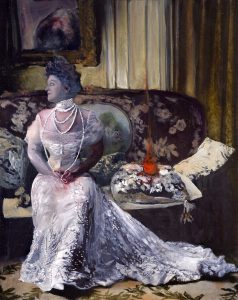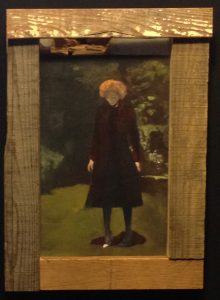
This month's cover artist is Sarah Zar, a Brooklyn, New York artist who works in mediums from oil paints and mixed media pieces to performance art. Sometimes collaborating with dead artists, Zar's cover piece this month offers a wonderful mix of reality and fantasy.
APEX MAGAZINE: Your piece, “Hurricane Woman,” seems to evoke both the physicality of the woman and the mysterious, fantastic nature of the waterfall. Do oil paints and the smaller size of the work (8″ x 10.75″) give you more time to work out the idea versus other media, or does it have to be fairly strong plan from the start?
Sarah Zar: Thank you. I love it when people help things seem.
I’m a bibliophile, so the intimate immediacy of that small scale is a pleasure. It envelops me, which helps with the more personal sketches. I made that specific piece in the ominous stillness of the night before Hurricane Sandy touched land. Making “Hurricane Woman” felt like being a flood. One moment I was watching my palette knife press linseed oil into a deathly pale blue, and the next, there was this woman looking back at me.
AM: On your C.V. page, you list being a presenter, curator, teacher, and musician. How much do you learn working with students, versus collaborators or even presenting or curating shows? Do you change how you create your work when you are collaborating with others, compared to working on something by yourself?
SZ: I like Jorge Luis Borges’ suggestion that the “imminence [from the Latin word imminere, ‘to overhang, impend, or be near’] of a revelation which does not occur is, perhaps, the aesthetic phenomenon.” Every time we make a connection or relationship of any kind, we are creating a new zone of nonverbal possibilities, between the inner worlds of everyone involved. As a result, the collaborative curation of perceptions (whether through literal curation, collaboration, presentation, or education) is an excellent place to harvest information and generate meaning. When I work alone, I try to adapt to the demands of the creation. When others are involved, the exploration is more about balancing webs of potential, and learning effective ways to process the translations that erupt between us.
AM: Your works include painting, photography, collage, and performance. When you have an art show, or even just designing the front page of your website, what are the challenges in showing potential viewers the differences in the types of your various projects? Do you find that individuals gravitate towards your overall works, or specific project areas?
SZ: I don’t worry about demonstrating everything to all of my viewers. Categorization is a tricky beast. People who are searching seem to find the specific bodies of work that allow them to recognize something Other in themselves. They don’t need to see everything. I’m a very big fan of secrets. I can’t speak for everyone else, but most of my collectors seem to be drawn to certain tropes rather than specific project areas. Once they find a certain type of hidden message, they seem to tune themselves to that pattern, and allow it to guide their eye.
AM: With acting and performance art, movement and sound seem to be just as important as the visual aspects. When you are approaching a new performance art piece, how much of it is a visual idea versus a more dynamic mix? Have you found times where a static art idea might work better than a performed piece, and vice versa?
SZ: Definitely. I’m extremely sensitized to subtle shifts in symbolic interactions (and slightly synaesthetic), so in my realms, absolutely everything influences everything else. Much of my solitary work spontaneously emerges in my mind as a psycho-spatial gestalt, and the work of processing it involves a mix of decisive intuition, visual logic, and lateral experimentation. The initial idea usually seems to demand a specific medium, but over time, inner archetypes tend to seep and peel off their masks. The longer you leave them in the dark, the more they have to tell you when you’re ready with a candle.
AM: Many of your works use rough wood for a frame, as in “Light Can Be The Undertow,” that matches the colors in the paintings well. Are your works typically fully painted before finding the wood for frames, or does the frame influence how you are creating your pieces? Do you have a process to determine which works get frames versus those that don't?
SZ: That’s an excellent question. Every physical, technical, or relational decision is symbolic of the internal logic of my piece. If things drain of color, contain an abyss, gain specificity or ambiguity, suddenly change styles, have dust gathered in certain areas, or glimmer under a certain light, it is to reinforce or alter the other information. I collect wood pieces and elements that have a lost history, and rely on poetic interpretations of their visual qualities to pair them with specific images. The paintings are usually complete before they meet their vessels, but sometimes it is necessary to enhance a visual connection, so I’ll add an extra trace.
Sarah Zar has a small art poem book called Riddled With Spots coming out this summer, and a much larger curatorial book is in progress. Her next body of work is a combination of installation, projection, paintings, and psychological amulets that deal with new stories to process the historical shifts taking place in our time. The project deals with oracles, evacuations, trauma, and the roles of deception and imagination in healing. Announcements, and galleries of her varied works, are available at SarahZar.com.












